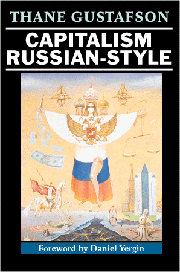Book contents
- Frontmatter
- Contents
- Foreword by Daniel Yergin
- Acknowledgments
- Prologue
- 1 The new Russian Revolution: false start or dead end?
- 2 Creating owners: insider privatization and its consequences
- 3 Wall Street comes to Moscow
- 4 The rise and fall of the private banks
- 5 No capitalism without capitalists: entrepreneurship in the new Russia
- 6 Russia's epidemic of crime
- 7 Toward the rule of law?
- 8 Beyond coping: toward the recovery of Russian society
- 9 The shrinking Russian state and the battle for taxes
- 10 Conclusion: halfway to the market Russia on the eve of the twenty-first century
- Bibliography
- Index
5 - No capitalism without capitalists: entrepreneurship in the new Russia
Published online by Cambridge University Press: 22 September 2009
- Frontmatter
- Contents
- Foreword by Daniel Yergin
- Acknowledgments
- Prologue
- 1 The new Russian Revolution: false start or dead end?
- 2 Creating owners: insider privatization and its consequences
- 3 Wall Street comes to Moscow
- 4 The rise and fall of the private banks
- 5 No capitalism without capitalists: entrepreneurship in the new Russia
- 6 Russia's epidemic of crime
- 7 Toward the rule of law?
- 8 Beyond coping: toward the recovery of Russian society
- 9 The shrinking Russian state and the battle for taxes
- 10 Conclusion: halfway to the market Russia on the eve of the twenty-first century
- Bibliography
- Index
Summary
April 1991, London:
The young Soviet deputy oil minister, Vagit Alekperov, was modest in manner, but quietly self-assured. He had come to London on a tour of oil companies and government offices, but also, intriguingly, of banks.
His delegation was strangely low-ranking compared to Alekperov himself. As the Soviet group took their chairs across the long table, Alekperov took in his group with a broad wave of his arm. “Allow me to introduce my colleagues,” he said. “Mr. Maganov of the Langepas Oil Company, Mr. Putilov of Urai, and Mr. Safin of Kogalym.”
Little did we realize at the time that the first letters Langepas, Urai, and Kogalym spelled LUK. In front of us was the beginning of Lukoil, today the leading oil company in Russia – and a name becoming known around the world.
June 1996, Moscow:
On Moscow's busy Leningradskoe Shosse we stopped at an unmarked door and entered a dark, deserted hallway. Stepping over trash and construction debris, we passed through a hole in a wall into an adjoining building, as gray and tumble-down as the first. I was beginning to wonder what I had gotten myself into, when my companion knocked on a steel-reinforced plate and we heard the sound of a police lock sliding aside.
From the gloom we stepped into a brightly-lit and ultra-modern workshop. Computer-driven printing presses rumbled, large computer screens shone brightly, young people bustled purposefully about, carrying four-color proofs. Stacks of brightly-printed calendars and posters were piled high, ready for shipment. An elegant, well-dressed woman greeted us with a smile, “Welcome to Raster. What you'll see here is as state-of-the-art as you'll find anywhere in the world.”
- Type
- Chapter
- Information
- Capitalism Russian-Style , pp. 108 - 133Publisher: Cambridge University PressPrint publication year: 1999



